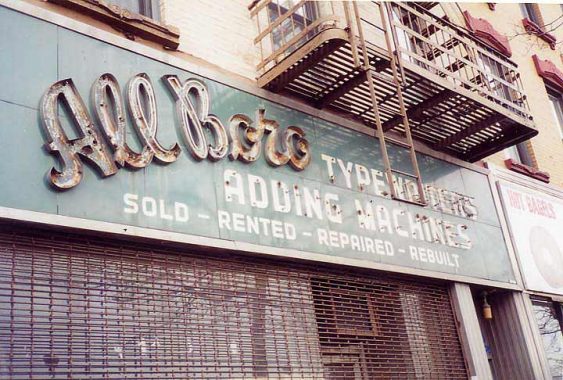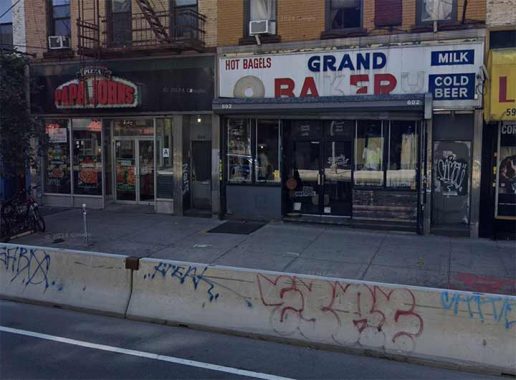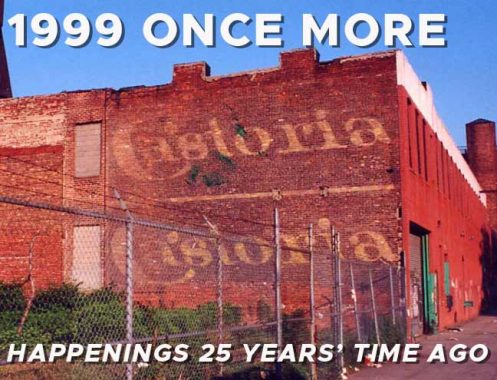
LIKE the hands on a clock, or the sun and moon in the sky, New York is under constant movement not always apparent to the naked eye. In the nearly 26 years since Forgotten NY launched in March 1999 with the intention of chronicling NYC’s unremarked-upon infrastructure which at times incorporates history and sociology, New York City has almost become a new city in some areas; for example, Greenpoint, Williamsburg and Hunters Point, on either side of Newtown Creek, have become new cities and have acquired cultures that were nascent or nonexistent when the Forgotten NY camera first explored them.
It hasn’t been my intention to do “New York Then and Now” features, since I consider that method imitative of what has been done previously. The New York Daily News did it best with their weekly “New York’s Changing Scene” feature in the Sunday color section in the 1960s-1970s. At this remove, though, few remember it. I hope to be indulged, though, because I recently went into the closet and pulled out some photos I hadn’t seen in years. I re-scanned them because in Forgotten NY’s early days dial-up modems were the most frequent way of accessing the internet and I scanned photos at nearly postage stamp size so they wouldn’t take all day to load. I still “save for web” to reduce loading time as much as I can.
Thus, some “then and now”-ing will pop up in posts the next few months as I make more discoveries in Forgotten New York’s own past. Some scenes have changed utterly, which will be what I will focus on. “Vacations in the past” as folk rocker Robyn Hitchcock puts it. All the photos in today’s feature, and all such future pieces, were photographed between 1998 and 2005.


Typewriter repair shops are nearly extinct, though Gramercy Typewriter is thriving on West 17th Street in Chelsea. I still own a 1940s Remington, though I’ll need a new ribbon for it and who knows where I can get vintage ribbon. Perhaps at Gramercy.
FNY has covered Brooklyn’s Grand Street on a couple of occasions, notably in 2013 when its many ancient painted ads and signs were still apparent. By that year, All-Boro Typewriter, between Lorimer and Leonard, had disappeared and had been replaced by a Papa John’s pizza franchise. A look at Street View reveals that the old sign disappeared in stages, with the “All-Boro” neon going first by 2008. The sign was linoleum with painted lettering overlaid with neon.
The plastic-lettered “Grand Bakery” sign next door remains, though by 2024 the K, Y and most of the E were gone.
The Harold Avenue (39th Street) Bridge spans the Sunnyside Yards connecting 39th Street in Sunnyside with Steinway Street in Astoria/LIC.
American Railway Express, later known as Railway Express Agency, a precursor to Federal Express, had offices in the Sunnyside Yards and a brick entrance on the bridge. As an added attraction, it sported one of only two remaining examples of the wall-bracketed version of the bishop crook lamppost remaining in New York City (it had lost its decorative scrollwork, and even its 1980s era sodium lamp had burned out). In the runup to East Side Access to Grand Central Terminal, this building and its lamp were removed. (The other wall bracket Crook is on Nassau Street near Pace University and was recently repaired.)
Until the early 2000s, the Honeywell Street and Harold Avenue (39th Street) bridges were rickety, potholed wrecks still employing dim incandescent lighting that the city was eventually forced to close. Apparently there was a difference of opinion over who was supposed to maintain it, the Department of Transportation or the various transit agencies that use the Sunnyside Yards. New bridges were constructed in the first decade of the 21st Century.
I first walked the Grand Concourse in 1999 all the way from 138th Street north to Mosholu Parkway, and while the bulk of it still looks the same with magnificent apartment buildings struggling mightily to remain magnificent, incremental changes have occurred. Back then I was not as thorough as I am now; upon spotting the Ascot Theater, at #2313 just north of East 183rd , I likely would have crossed over to get a better look at it especially in light of the coming attraction on the marquee. As it is, I shot it from the east side of the road without using a zoom. Yesterday, I cropped it and scanned at a high resolution, but this fuzzy image is the best I could do.
The Ascot opened in 1935 and closed sometime in the early 2000s; after 2016, it and the neighboring buildings were demolished, and today it’s an empty lot awaiting development. In its later years it showed adult films and despite the marquee listing, was never used as a church. Unusually, its marquee-type signage was flat against the building and not on an overhang.
Though I have been showing a photo of the IRT subway original 1908 Brooklyn terminal building at Times Plaza (Flatbush, Atlantic and 4th Avenues) in various powerpoint presentations during FNY 25th anniversary talks during 2024, I seemed to have taken numerous photos of it in 1999, which was between the time the surrounding food vendors and newsstands were removed and the original building, in its deteriorated glory, was revealed. In 1999 there was still a subway entrance there, but when it was rehabbed in the 2000s, the entrance was removed and it is now pretty much a skylight above the concourse below.
In the background is One Hanson, the Williamsburg Bank Building (I call it the House of Pain because of its oral surgeons). It’s hard to believe it was Brooklyn’s tallest building for the better part of 8 decades.
There’s a lot to talk about with these ads at 9425 5th Avenue across from its junction with 4th Avenue at “Pigeon Park” in Bay Ridge I captured in 1999. The painted ad says “Harmon Wine Market” and “Liquor.” Liquor store signs and ads tend to hang in there longer than many other types of ads and signs; often, liquor stores are unnamed, and there’s no need to change the sign. Additionally, the signmaker often has fun with the letter “Q” since that letter has numerous design possibilities. In 1999, the painted ad was accompanied by a liquor store, with the added attraction of a subway entrance.
The car service ad has an old telephone exchange, SH, which in Bay Ridge stood for SHore Road. Lower right, we have a blue and white sign signifying a public phone, which are nearly extinct by 2024.
These ads were whitewashed away long ago but in 2022 there was a painted ad for a car service, as well as some preprinted ads, on the building.
I’ve covered the old Bomelstein’s Clock on Manhattan in Greenpoint before, so no need to repeat it here: but I finally scanned my original 1999 photo at a decent size.
Look at the brilliant color in this shot of a former burlap bag factory at Central Avenue and George Street in Bushwick in 1999. I loved the color saturation in Kodachrome film. I shot with film in Forgotten NY’s early days, but it cost quite a bit and I got plenty of unusable shots as a novice photographer. Practicalities forced me to begin using digital cameras in 2005 or 2006. I can’t quite get this kind of color saturation with them without serious camera adjustments or in Photoshop.
In the 1929 Belcher Hyde Brooklyn atlas this building is marked Frederick Elfern & Sons; I don’t know if they were the burlap bag people. The building itself is a magnificent brick structure (I prefer brick architecture above everything else) currently used a church and for other uses. Most of the frontage is along George Street.
I walked Central Avenue in 2018 and got a photo of the building then. The painted sign is obscured behind a sign advertising the church.
|
|
|
I can’t resist showing a tax photo of the building in 1940 when the “Acme Burlap Bag Co., Inc.” painted sign was new.
This shot isn’t mine, it’s by the late great Gary Fonville on East 134th Street between Alexander and Lincoln Avenues in Mott Haven, Bronx in the early 2000s; it originally appeared on a page of Bronx painted ads that he captured in 2004. This is the first large scan I have obtained.
Castoria ads have been a staple in the Forgotten New York ancient painted ads category from the very beginning, back in 1999. They can be seen frequently in photographs of NYC from the early 20th Century and were absolutely ubiquitous. An extraordinarily high grade of paint must have been used to produce them as many have stood up to full sunshine for over a century.
Fletcher’s Castoria, marketed as a gentle stomach remedy for kids, has been sold since 1871 when Charles Henry Fletcher purchased the rights to a formula developed by Dr. Samuel Pitcher as a cathartic. It has been marketed ever since then, though in recent years the “Castoria,” (for castor oil) has been dropped and it’s now called Fletcher’s Laxative for Kids, though adults can also use it.
Castoria was marketed extensively through much of the 20th Century, with large painted ads appearing on sides of buildings in major cities. The paint used proved quite resistant to sun bleaching; only during the last 20 years have they started to fade considerably.
This ad is different from other Castoria ads I have seen around town because it doesn’t have the script Charles H. Fletcher signature, or slogans like “Children Cry For…” Just the name of the preparation rendered twice. There’s no trace today, as new apartment buildings have appeared along this stretch. 2007 seems to have been the demolition date.
These iron stanchions were placed near expressways and parkways entrances until the 1960s, when more massive poles carrying standard green and white signs appeared. Before that, white with black lettering was the standard, illuminated by incandescent bulbs. Don’t let their small stature fool you, these poles could probably withstand tank collisions. The scene is at the entrance/exit of the Brooklyn-Queens Expressway on Columbia Street south of Atlantic Avenue.
More 25th anniversary fun in the coming weeks.
As always, “comment…as you see fit.” I earn a small payment when you click on any ad on the site. Take a look at the new JOBS link in the red toolbar at the top of the page on the desktop version, as I also get a small payment when you view a job via that link.
12/29/24
